Candid Camera
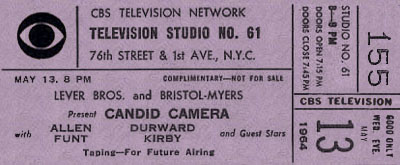
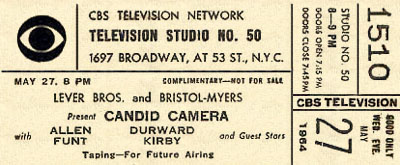
New York born producer Allen Funt started Candid Microphone in 1947 as a series on ABC radio. The premise was pretty simple: Play tricks on people and record the fun with a hidden microphone. The radio show led quickly to a TV version and a series of film shorts, and soon it was all called Candid Camera. Funt and his merry band of tricksters appeared all over the TV dial throughout the fifties, either as a guest spot or a recurring segment on other shows like The Garry Moore Show or The Tonight Show. There was also a short-lived syndicated series.
But the franchise didn’t really take off until 1960 when CBS bought a weekly prime-time series that lasted until 1967. Funt co-hosted with Arthur Godfrey at first, then Durward Kirby and later, Bess Myerson. There were a couple of later syndicated versions but the tickets above are from the CBS run. You’ll notice that though they’re from the same month, they’re for different studios. That’s because Candid Camera was the wandering nomad of the CBS lineup. The network had several studios in Manhattan and Candid Camera would tape in whichever one wasn’t busy at the moment. They could do this because the set was so simple and all the show required was for two people to sit in chairs and talk.
I never cared much for “hidden camera” prank shows but that may be because Funt’s many imitators gave the premise a bad name. None of them ever did it as well.
That’s Life
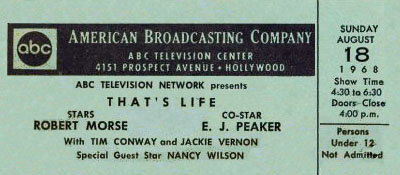
That’s Life was an extremely original and daring concept in TV: An hour-long ongoing sitcom and musical comedy that each week featured songs (some written for the show, some not) and dances. Robert Morse was the star and the show had something of the feel of his hit, How to Succeed in Business Without Really Trying. He played a young man named Robert Dickson while E.J. Peaker played his new wife, Gloria Quigley.
Each week, we got another chapter of their evolving life together, and there were guest stars aplenty. Among those who appeared, sometimes more than once as recurring characters, were Ethel Merman, Mel Tormé, Phil Silvers, Leslie Uggams, Paul Lynde, Vikki Carr, Mahalia Jackson, Alan King, Robert Goulet, Tony Randall and Liza Minnelli. Shelley Berman and Kay Medford turned up often as Gloria’s parents. The show also found ways to incorporate musical groups and their hits into its plot each week. On the first episode, which aired September 24, 1968, The Turtles sang “Eleanor.”
The above ticket is for August 18 and it’s for the second episode, which was telecast October 1 and told the story of how Bobby decided to ask Gloria to marry him. During the course of the hour, guest star Nancy Wilson sang “Marriage Blues,” E.J. Peaker sang, “It Must Be Him,” Morse sang, “Embarrassment of Riches,” Morse and Peaker sang “Our Love is Here to Stay” and”The Two of Us,” and Wilson and Peaker sang, “To Get a Man.” Guest stars Tim Conway and Jackie Vernon didn’t sing.
The series was a critical hit but that was about it. Audiences never discovered it…or if they did, they didn’t much like what they were watching. Twenty-six episodes were produced with the last airing April Fool’s Day of ’69. There were a few week of reruns and then the timeslot (Tuesday nights at 10) was given over to one night of a thrice-weekly Dick Cavett Show. That’s Life was never rerun again, which is a shame. It was one of those shows that deserved more of a chance.
Queen for a Day
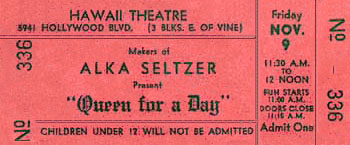
Queen For A Day was an offensive, voyeuristic show that capitalized on the misery of its contestants, and I’m surprised no one has tried reviving it lately. Basically, a number of women were paraded on camera each episode to tell why they should be named “Queen For A Day” and awarded a big prize package. Ostensibly, that honor was to go to someone who’d done something to deserve it, but the show usually devolved into the ladies telling about how awful their lives were; how their husbands had left them or died and how their mother was ill and how the roof on their home was collapsing, etc. Somehow, went the premise, some of this would be put right and their lives set on a happier course if the show’s studio audience would vote them “Queen For A Day” which meant they’d get crowned with a tiara and sent home with a box of small appliances. There were a lot of tears, and I guess America’s homemakers liked to watch and cry along, and think, “Thank God that woman has it worse than me,” or something of the sort. An awful spectacle, especially when you considered all the women who cried and poured their hearts out on network TV and didn’t even win the Waring Blender and the case of Noxzema that the winner got.
The show moved around to various studios in Hollywood, broadcasting for a time from (as above) the Hawaii Theatre , which was another of Sid Grauman’s “international” film palaces. The Chinese and The Egyptian were, and still are, further west on Hollywood. The Hawaiian is now a Salvation Army church. I’m guessing the above ticket is from 1953, when the show was seen only on television in Los Angeles. It went network in 1956 on NBC, moved to ABC in 1960 and finally went off in 1964.
Real People
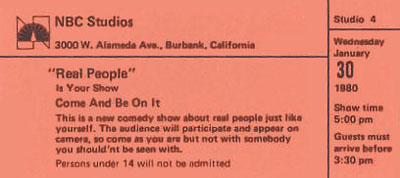
Real People, which some might call the first prime-time TV “reality show,” debuted on April 18, 1979. So I’m not sure why a ticket for a taping more than nine months later is composed as if attendees had never heard of it. Nevertheless, this is one of the few TV tickets I’ve ever seen that felt it had to explain a little about the show and even make a joke, warning people not to show up “with somebody you should’nt [sic] be seen with.” For those who don’t remember, the idea of Real People was that the show’s correspondents would just spotlight and salute interesting folks around the country. Produced by George “Laugh-In” Schlatter, the series was enormously popular for most of its five years and briefly made stars out of some of those it covered, and spawned a short-lived spin-off, Schlatter’s Speak Up, America. Also, one of the hosts, John Barbour, was inspired to go out and sell something called That @&$# Quiz Show.






